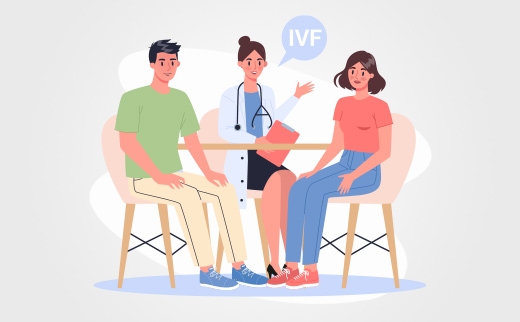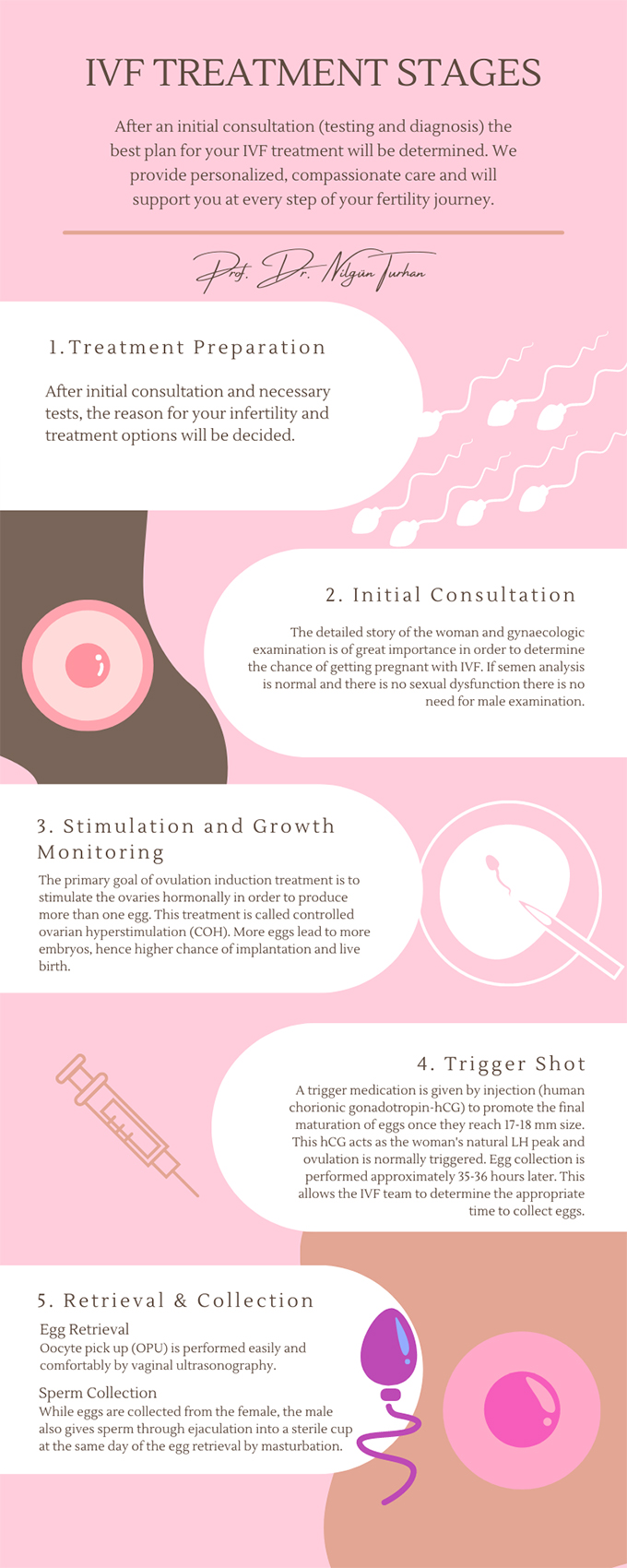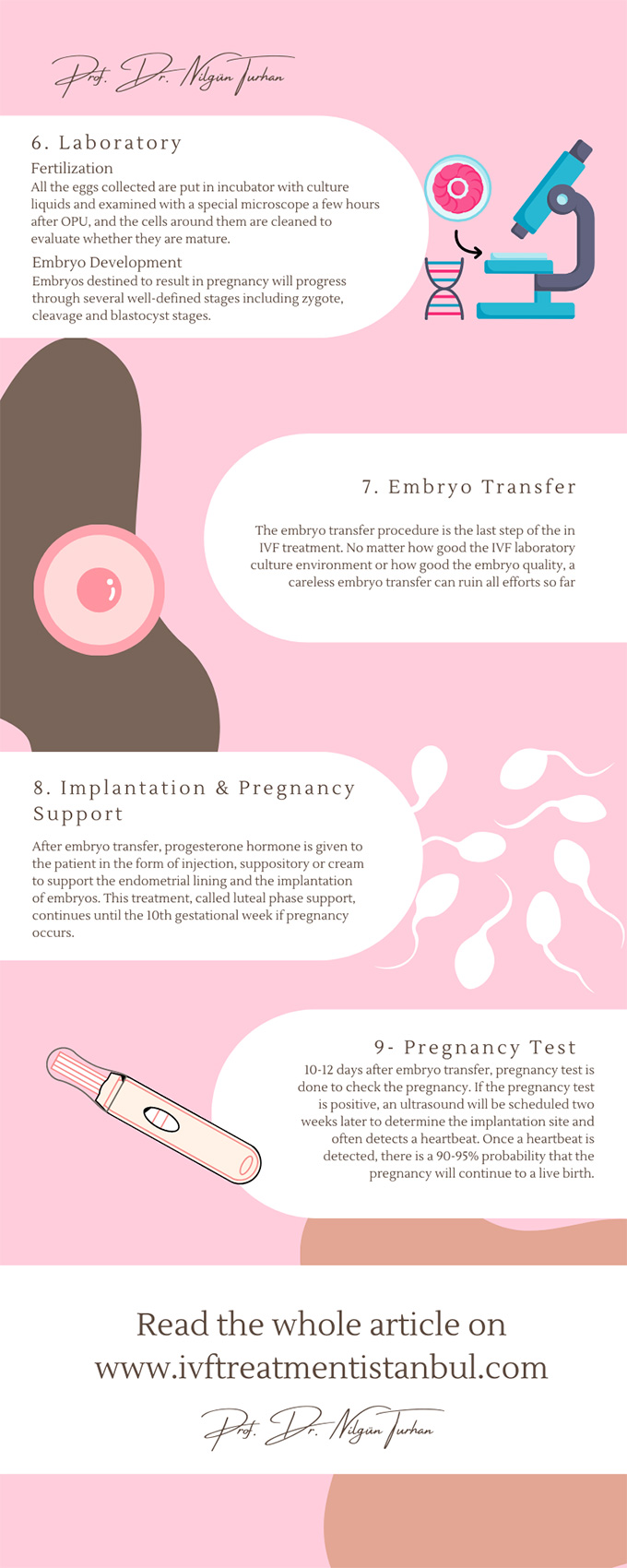
After an initial consultation (testing and diagnosis) the best plan for your IVF treatment will be determined. We provide personalized, compassionate care and will support you at every step of your fertility journey.
After initial consultation and necessary tests, the reason for your infertility and treatment options will be decided. If you provide all your recent tests and medical reports by e-mail or WhatsApp, we can decide on your IVF treatment protocol before coming to Istanbul.
Tests that are requested are:
Woman:
Man:
The detailed story of the woman and gynaecologic examination is of great importance in order to determine the chance of getting pregnant with IVF. If semen analysis is normal and there is no sexual dysfunction there is no need for male examination.
The age of the woman, the duration of infertility, the results of previous examinations, laboratory tests and treatments, the menstrual cycle, medical, surgical and gynecological history (sexually transmitted disease, pelvic inflammatory disease history, treatment of abnormal PAP smear, previous abdominal surgery),thyroid diseases, hirsutism, pelvic or lower abdominal pain, menstrual pain and pain during sexual intercourse are questioned.
Pregnancy history (pregnancy, birth, pregnancy outcomes and related complications),sexual history (frequency of intercourse, sexual dysfunction),family history (whether there is an infertile member in the family, early menopause history in the family, birth defects, genetic disorders, mental retardation),a careful and comprehensive understanding of his/her life style (work, exercise, stress factors, weight changes, smoking and alcohol use) are questioned.
Weight and body mass index (increased body mass index is associated with decreased fertility, abdominal obesity is associated with insulin resistance),development of secondary sex characteristics, body type (development of secondary sex characters is insufficient in hypogonadotropic hypogonadism, short stature, mane neck is observed in Turner syndrome) determines.
The primary goal of ovulation induction treatment is to stimulate the ovaries hormonally in order to produce more than one egg. This treatment is called controlled ovarian hyperstimulation (COH). More eggs lead to more embryos, hence higher chance of implantation and live birth.
After basic ultrasound examination of ovaries and blood hormone levels on the second or third day of menstrual bleeding the protocol and the drug doses to be used is decided. The type and dose of medication may vary depending on the patient and treatment protocol applied.
Ovarian stimulation typically begins on days 2-3 of a woman’s cycle. After the stimulation treatment begins, the patient is called for control at regular intervals for ultrasound monitoring. In these controls, the number and size of the developing follicles (small fluid-filled cystic structures containing eggs) and endometrial lining are checked by vaginal ultrasonography. Timing is very important in the IVF cycle. The duration of treatment varies, but the average is 10-12 days.
A trigger medication is given by injection (human chorionic gonadotropin-hCG) to promote the final maturation of eggs once they reach 17-18 mm size. This hCG acts as the woman's natural LH peak and ovulation is normally triggered. Egg collection is performed approximately 35-36 hours later. This allows the IVF team to determine the appropriate time to collect eggs.

Egg Retrieval
Oocyte pick up (OPU) is performed easily and comfortably by vaginal ultrasonography. The patient lies in gynecological examination position under light anesthesia and is covered with sterile drapes. The ultrasound probe is placed in the vagina. When mature follicles are identified in the ovary, the follicles are entered through the vagina under the guidance of a needle. The egg in the follicular fluid is taken out with the help of a special aspirator. All the follicular fluids are collected and given to embryology lab. OPU lasts approximately 5-10 minutes. After OPU, the patient is taken to her room and rests for a while. The number of eggs retrieved depend on woman’s age, history, fertility diagnosis, ovarian reserve, and response to medications.
Sperm Collection
While eggs are collected from the female, the male also gives sperm through ejaculation into a sterile cup at the same day of the egg retrieval by masturbation. In men who do not have live sperm in their semen, sperm is surgically taken through TESA/PESA or TESE procedure. If the male partner will not able to be in the clinic on the OPU day, the sperm can be collected and frozen before egg collection day and thawed in the morning of OPU day. The semen obtained is placed in a special container and expected to become liquefied. Liquefied semen is examined by microscope to evaluate sperm count, motility and shape. Once this process is complete, the motile sperm is transferred to the embryology lab where fertilization will take place by ICSI method.
Fertilization
All the eggs collected are put in incubator with culture liquids and examined with a special microscope a few hours after OPU, and the cells around them are cleaned to evaluate whether they are mature. The incubator keeps the temperature 37 ° C and the carbon dioxide ratio constant at 5-6%. Out of all of the eggs collected from 17-20 mm size follicles approximately 80% are mature and ready for ICSI (Intracytoplasmic Sperm Injection) after 4-6 hours. In ICSI procedure one single sperm is picked up with a micro manipulator and hollow needle and injected directly to each egg. Embryos are formed as a result of fertilization of eggs.
Embryo Development
Embryos destined to result in pregnancy will progress through several well-defined stages including zygote, cleavage and blastocyst stages. Two days after fertilization, normal embryos are between two and six cells. Three days after fertilization, most normal embryos are between seven and nine cells. Four days after fertilization, most normal embryos have reached the morula stage (too many cells to reliably count with a microscope). In the fifth day after egg collection and ICSI procedure the embryo is named as blastocyst. Blastocysts are embryos that are nearly ready to implant. If an embryo is grown to a blastocyst stage, it can then be genetically tested. While this may be beneficial for some, it is not recommended for everyone.
The embryo transfer procedure is the last step of the in IVF treatment. No matter how good the IVF laboratory culture environment or how good the embryo quality, a careless embryo transfer can ruin all efforts so far. For this reason, the experience of the doctor performing embryo transfer has a very critical importance on pregnancy rates. The entire IVF cycle depends on delicate placement of the embryos at the proper location near the middle of the endometrial cavity - with minimal trauma and manipulation.
Embryo transfer is a painless procedure and does not require anesthesia. During the embryo transfer, the patient lies on the table in gynecological position. After the speculum is inserted to the vagina, cervix is cleaned with sterile fluids. The embryologist loads one or two embryos into a very thin, flexible plastic catheter. Embryo(s) are transferred after 2 to 5 days of fertilization, from the two-cell stage to the blastocyst stage.
We use ultrasound guided embryo transfer with a moderately full bladder. Ultrasound helps us to visualize the smooth catheter so the embryos are placed in the best location. The catheter is gently inserted into the endometrial lining of the uterus and the embryos are offloaded with the help of a small syringe to implant and further develop. If the embryo attaches to uterine lining endometrium, then pregnancy results.
Any remaining embryos that are not transferred can be frozen and used for a subsequent Frozen Thawed Embryo Transfer cycle.
After embryo transfer, progesterone hormone is given to the patient in the form of injection, suppository or cream to support the endometrial lining and the implantation of embryos. This treatment, called luteal phase support, continues until the 10th gestational week if pregnancy occurs.
10-12 days after embryo transfer, pregnancy test is done to check the pregnancy. If the pregnancy test is positive, an ultrasound will be scheduled two weeks later to determine the implantation site and often detects a heartbeat. Once a heartbeat is detected, there is a 90-95% probability that the pregnancy will continue to a live birth.

(Translated by Google) I must sincerely say that, most importantly, the only doctor who treats the other person as a human and a mother everything to your heart's heart, Nilgün Hanım, who...